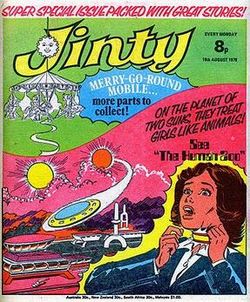Jinty (comics) facts for kids
Jinty was a weekly British comic for girls published by Fleetway in London from 1974 to 1981, at which point it merged with Tammy. It had previously merged with Penny in a similar fashion, illustrating the 'hatch-match-dispatch' process practiced by editorial staff in the London comics publisher.
As well as the weekly comic, Christmas annuals were also published. While there were similarities with its Fleetway stablemates Tammy and Misty, each comic had its own focus, with Jinty concentrating on science fiction or otherwise fantastical stories.
Contents
Publishing format
As with other girls' comics of the time, Jinty consisted of a collection of many small strips. A typical weekly issue would publish six or seven serial stories, each consisting of around three or four pages of story ending in a cliff-hanger. The first page of the story included a text-box briefly summarizing the story so far, while the final page included a teaser line of text for the next week's episode.
In addition to the serial stories, a few standalone strips were normally published. Usually, these were humorous and featured the same lead character week after week. Alley Cat, Penny Crayon, and others were a single page long, while Sue's Fantastic Fun-Bag! ran to two pages each week. A lead strip in the early days, often taking the cover slot, was The Jinx From St Jonah's, which normally featured a standalone story but occasionally continued it in a subsequent week. An exception to the humour format was the storyteller format, in which the same narrator would each week tell a different spooky or eerie story. In Jinty, that narrator was the character Gypsy Rose.
Other features includes a letters page, horoscopes, occasional text stories, feature articles on pop or media stars, and various articles on creative things to make and do.
Jinty was printed on newsprint using at most two colours on internal pages and a four-colour process on the external cover pages.
Jinty also merged with Lindy during 1976 and carried into 1977.
Contributors
Artists
Artists featured in the pages of Jinty included:
- Phil Gascoine — in each issue from the very first until the last, from Gail's Indian Necklace to Badgered Belinda. Gascoine was the artist for No Cheers for Cherry, and Fran of the Floods
- Guy Peeters — Land of No Tears, Black Sheep of the Bartons, I'll Make up for Mary, Slave of the Swan, The Human Zoo, Worlds Apart, and Pandora's Box
- Jim Baikie — Left-Out Linda, Face The Music, Flo!, Ping-Pong Paula, Miss No-Name, Willa on Wheels, Rose Among the Thornes, Spell of the Spinning Wheel, Two Mothers for Maggie, Wild Rose, and The Forbidden Garden
- Philip Townsend — Somewhere over the Rainbow, Mark of the Witch!, Children of Stepford, and Song of the Fir Tree
- Keith Robson
- Audrey Fawley — Made Up Mandy
- José Casanovas, Trini Tinturé, Rodrigo Comos, and many other Spanish artists
Writers
Writers featured included:
- Pat Mills — Land of No Tears, Girl in a Bubble, Concrete Surfer
- Malcolm Shaw — The Robot Who Cried
- Jay Over — Pam of Pond Hill
- Terence Magee — Merry At Misery House


